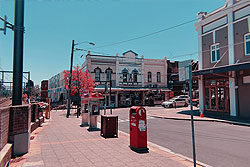NAATI Certified Translation for Stanmore
Certified translation examples from Sydney Translation Services.
Driver License
Birth Certificate
Passport Translation
Marriage Certificate
Death Certificate
Divorce Certificate
Degree Certificate
No-Criminal Record
The Gupapuyngu Language

- Unique Phonology: Gupapuyngu, a Yolŋu Matha language of North-East Arnhem Land, features a rich phonological system with distinct sounds that are uncommon in many other languages. Translators must be attuned to the specific sounds and pronunciations to accurately convey meaning, especially when dealing with oral histories or culturally significant texts.
- Oral Tradition: Gupapuyngu is traditionally an oral language, with written forms developed more recently. As such, much of the translation work involves transcribing spoken language, which requires a deep understanding of cultural context and oral storytelling techniques.
- Contextual Sensitivity: Many words and phrases in Gupapuyngu are deeply tied to cultural practices and the local environment. Translators need to ensure that these cultural nuances are preserved in the translation, especially when dealing with ceremonial or traditional knowledge, where mistranslation could lead to significant misinterpretations.
- Translating Legal and Educational Documents: Gupapuyngu is increasingly used in legal and educational contexts, especially in the Northern Territory. Translators working on these types of documents need to ensure that the correct legal and academic terminology is employed, respecting both the traditional language structure and the specific requirements of official communication.
About Stanmore
 Stanmore is a suburb in the Inner West of Sydney, in New South Wales, Australia 6 kilometres south-west of the Sydney central business district. It is part of the local government area of Marrickville Council. Stanmore was named by a prosperous saddler, John Jones, who purchased land in 1835 where Newington College now stands and called it the Stanmore Estate.
Stanmore is a suburb in the Inner West of Sydney, in New South Wales, Australia 6 kilometres south-west of the Sydney central business district. It is part of the local government area of Marrickville Council. Stanmore was named by a prosperous saddler, John Jones, who purchased land in 1835 where Newington College now stands and called it the Stanmore Estate.
Jones named it after his birthplace of Stanmore,now a north west suburb of London. Land in the present Stanmore area was first allocated to colonial officers by Governor Phillip between 1793 and 1810. Thomas Rowley owned Kingston Farm which occupied the eastern half of Stanmore and much of Newtown, and a portion of George Johnston's Annandale estate covered the area south of Parramatta Road containing Annandale House built in 1799 on the hill between Macaulay and Albany Roads. It was from here where Johnston marched with his troops to Castle Hill on 5 March 1804 to quell the convict revolt and where he rode on 26 January 1808 to arrest Governor Bligh during the Rum Rebellion. The first Norfolk pines on the Australian mainland were planted along the line of Percival Road, leading to Parramatta Road by Lt Colonel George Johnston.
Stanmore Road was constructed in 1835 and early development occurred in this area. In 1855, the railway divided Stanmore in to areas known as North and West Kingston north of the railway, and South Kingston south of the railway. The Kingston Farm had been sold to James Holt in 1835, and North Kingston was subdivided in 1854. South Kingston (between the railway and Stanmore Road) was slowly subdivided from 1857 with isolated large houses built between 1860 and 1870. It was not until the late 19th century that the name Stanmore came into more regular use, replacing Kingston.
Other Gupapuyngu Translation Service Locations
St Marys Gupapuyngu Translator, St Peters Gupapuyngu Translator, Stanhope Gardens Gupapuyngu Translator, Strathfield Gupapuyngu Translator, Summer Hill Gupapuyngu Translator, Surry Hills Gupapuyngu Translator.




 Stanmore is a suburb in the Inner West of Sydney, in New South Wales, Australia 6 kilometres south-west of the Sydney central business district. It is part of the local government area of
Stanmore is a suburb in the Inner West of Sydney, in New South Wales, Australia 6 kilometres south-west of the Sydney central business district. It is part of the local government area of